Macquarie University PSYC105 Report: Cell Phone Use and Young Drivers
VerifiedAdded on 2023/06/04
|14
|5659
|418
Report
AI Summary
This PSYC105 report investigates the factors contributing to cell phone use while driving among young adults and proposes prevention strategies. The study, conducted via an online survey of 343 young drivers aged 15-26, examines the impact of texting and talking on driving behavior. The research e...
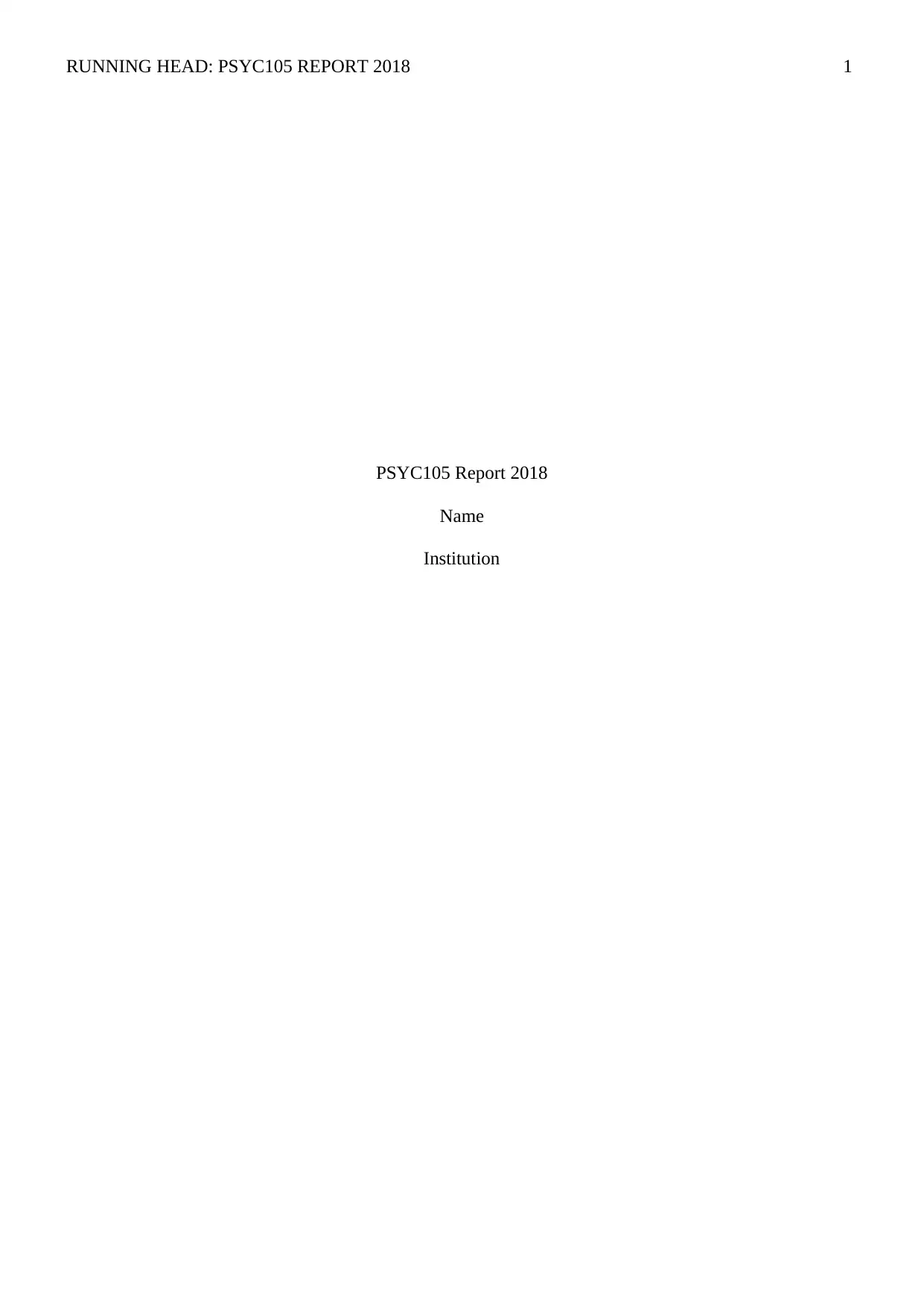
RUNNING HEAD: PSYC105 REPORT 2018 1
PSYC105 Report 2018
Name
Institution
PSYC105 Report 2018
Name
Institution
Paraphrase This Document
Need a fresh take? Get an instant paraphrase of this document with our AI Paraphraser
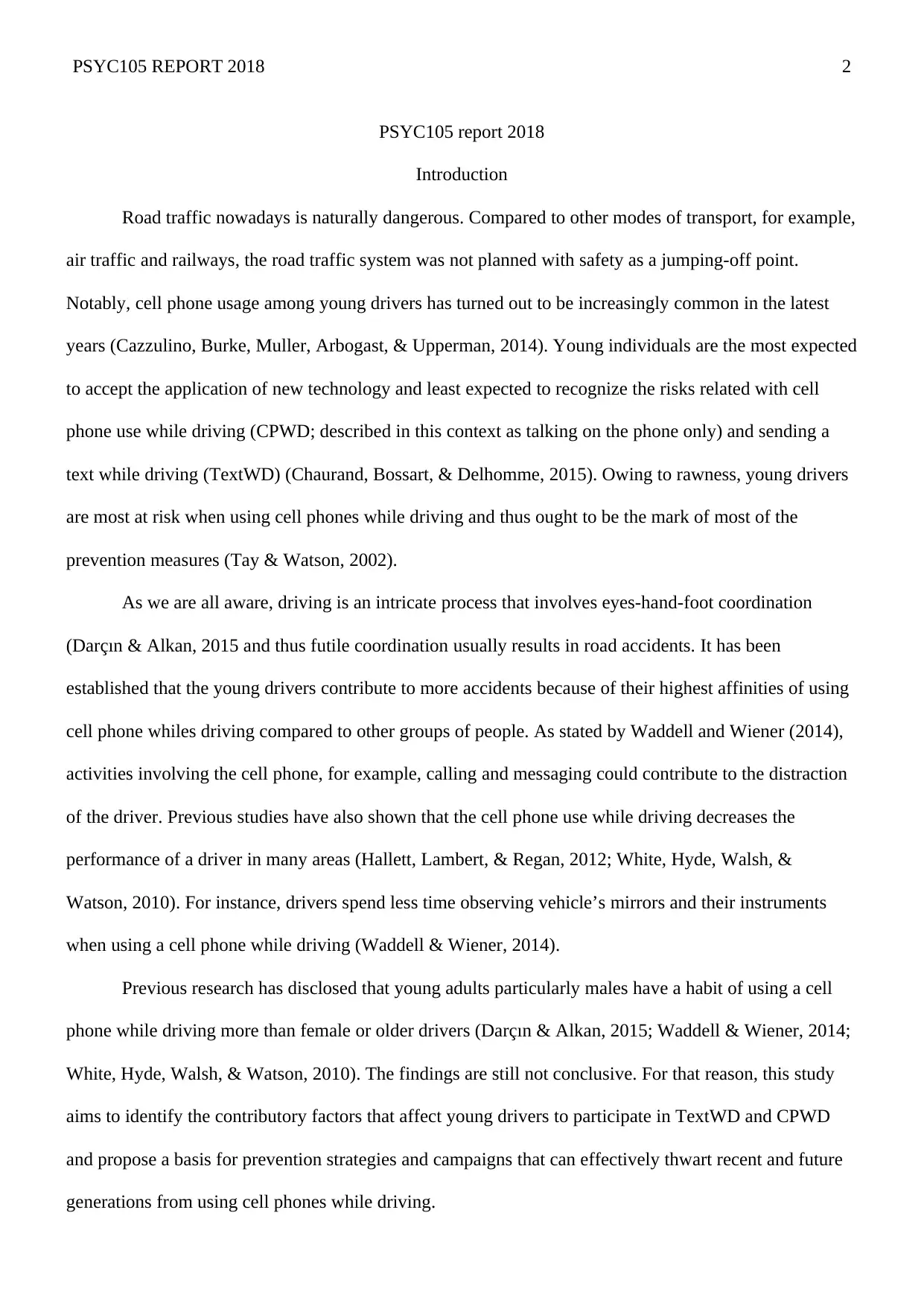
PSYC105 REPORT 2018 2
PSYC105 report 2018
Introduction
Road traffic nowadays is naturally dangerous. Compared to other modes of transport, for example,
air traffic and railways, the road traffic system was not planned with safety as a jumping-off point.
Notably, cell phone usage among young drivers has turned out to be increasingly common in the latest
years (Cazzulino, Burke, Muller, Arbogast, & Upperman, 2014). Young individuals are the most expected
to accept the application of new technology and least expected to recognize the risks related with cell
phone use while driving (CPWD; described in this context as talking on the phone only) and sending a
text while driving (TextWD) (Chaurand, Bossart, & Delhomme, 2015). Owing to rawness, young drivers
are most at risk when using cell phones while driving and thus ought to be the mark of most of the
prevention measures (Tay & Watson, 2002).
As we are all aware, driving is an intricate process that involves eyes-hand-foot coordination
(Darçın & Alkan, 2015 and thus futile coordination usually results in road accidents. It has been
established that the young drivers contribute to more accidents because of their highest affinities of using
cell phone whiles driving compared to other groups of people. As stated by Waddell and Wiener (2014),
activities involving the cell phone, for example, calling and messaging could contribute to the distraction
of the driver. Previous studies have also shown that the cell phone use while driving decreases the
performance of a driver in many areas (Hallett, Lambert, & Regan, 2012; White, Hyde, Walsh, &
Watson, 2010). For instance, drivers spend less time observing vehicle’s mirrors and their instruments
when using a cell phone while driving (Waddell & Wiener, 2014).
Previous research has disclosed that young adults particularly males have a habit of using a cell
phone while driving more than female or older drivers (Darçın & Alkan, 2015; Waddell & Wiener, 2014;
White, Hyde, Walsh, & Watson, 2010). The findings are still not conclusive. For that reason, this study
aims to identify the contributory factors that affect young drivers to participate in TextWD and CPWD
and propose a basis for prevention strategies and campaigns that can effectively thwart recent and future
generations from using cell phones while driving.
PSYC105 report 2018
Introduction
Road traffic nowadays is naturally dangerous. Compared to other modes of transport, for example,
air traffic and railways, the road traffic system was not planned with safety as a jumping-off point.
Notably, cell phone usage among young drivers has turned out to be increasingly common in the latest
years (Cazzulino, Burke, Muller, Arbogast, & Upperman, 2014). Young individuals are the most expected
to accept the application of new technology and least expected to recognize the risks related with cell
phone use while driving (CPWD; described in this context as talking on the phone only) and sending a
text while driving (TextWD) (Chaurand, Bossart, & Delhomme, 2015). Owing to rawness, young drivers
are most at risk when using cell phones while driving and thus ought to be the mark of most of the
prevention measures (Tay & Watson, 2002).
As we are all aware, driving is an intricate process that involves eyes-hand-foot coordination
(Darçın & Alkan, 2015 and thus futile coordination usually results in road accidents. It has been
established that the young drivers contribute to more accidents because of their highest affinities of using
cell phone whiles driving compared to other groups of people. As stated by Waddell and Wiener (2014),
activities involving the cell phone, for example, calling and messaging could contribute to the distraction
of the driver. Previous studies have also shown that the cell phone use while driving decreases the
performance of a driver in many areas (Hallett, Lambert, & Regan, 2012; White, Hyde, Walsh, &
Watson, 2010). For instance, drivers spend less time observing vehicle’s mirrors and their instruments
when using a cell phone while driving (Waddell & Wiener, 2014).
Previous research has disclosed that young adults particularly males have a habit of using a cell
phone while driving more than female or older drivers (Darçın & Alkan, 2015; Waddell & Wiener, 2014;
White, Hyde, Walsh, & Watson, 2010). The findings are still not conclusive. For that reason, this study
aims to identify the contributory factors that affect young drivers to participate in TextWD and CPWD
and propose a basis for prevention strategies and campaigns that can effectively thwart recent and future
generations from using cell phones while driving.

PSYC105 REPORT 2018 3
Research Hypothesis
The three hypothesis of this present study can be stated as Gain-framed, compared to loss-framed,
safety messages about mobile phone use while driving will be more effective in changing people's
intentions towards this behaviour ; high issue involvement inducing, compared to low issue involvement
inducing, safety messages will be more effective in changing people's intentions about unsafe driving
behaviour and; gain-framed safety messages about mobile phone use will be most effective when paired
with a high issue involvement inducing message
Method
Sample Population
The survey was rolled online and completed by 892 teens and young adult drivers, but only 343
were considered as the rest were deemed incomplete. All the 343 informants met all of the screening
standards: had learner’s permit or a driver’s license, drove more often, possessed a cell phone and were
aged between 15 and 26 years. Eighty six (25.07%) of the respondents were male and 255 (74.34) were
female.
Procedure
The survey was piloted using Qualtrics® software (from August 24 to September 2018). The
respondents were invited to cooperate on a web survey about the association between the use of mobile
phone while driving and the age. The enumerator clarified to the informants what the survey was all about
before its start and presented a consent form from the Macquarie University, Department of Psychology.
Additionally, the participants were assured that their identity would remain anonymous throughout the
study and their responses would only be used for study purpose. Then, all the participants were asked to
evaluate the content of a set of questions about the use of the phone while driving and some road safety
parameters. On average, it took the participants 15-20 minutes to complete the online questionnaire.
Materials
The road carnage imaged used in the introduction part of the questionnaire was intentionally used
Research Hypothesis
The three hypothesis of this present study can be stated as Gain-framed, compared to loss-framed,
safety messages about mobile phone use while driving will be more effective in changing people's
intentions towards this behaviour ; high issue involvement inducing, compared to low issue involvement
inducing, safety messages will be more effective in changing people's intentions about unsafe driving
behaviour and; gain-framed safety messages about mobile phone use will be most effective when paired
with a high issue involvement inducing message
Method
Sample Population
The survey was rolled online and completed by 892 teens and young adult drivers, but only 343
were considered as the rest were deemed incomplete. All the 343 informants met all of the screening
standards: had learner’s permit or a driver’s license, drove more often, possessed a cell phone and were
aged between 15 and 26 years. Eighty six (25.07%) of the respondents were male and 255 (74.34) were
female.
Procedure
The survey was piloted using Qualtrics® software (from August 24 to September 2018). The
respondents were invited to cooperate on a web survey about the association between the use of mobile
phone while driving and the age. The enumerator clarified to the informants what the survey was all about
before its start and presented a consent form from the Macquarie University, Department of Psychology.
Additionally, the participants were assured that their identity would remain anonymous throughout the
study and their responses would only be used for study purpose. Then, all the participants were asked to
evaluate the content of a set of questions about the use of the phone while driving and some road safety
parameters. On average, it took the participants 15-20 minutes to complete the online questionnaire.
Materials
The road carnage imaged used in the introduction part of the questionnaire was intentionally used
⊘ This is a preview!⊘
Do you want full access?
Subscribe today to unlock all pages.

Trusted by 1+ million students worldwide

PSYC105 REPORT 2018 4
to present the content of the road safety and ramifications when these regulations are violated to sway the
attention of the target respondents towards giving honest answers about various parameters of the study
topic (Tay, 2005). This image was also accompanied by phone texting image by a person who is driving
and very reluctant to observe what is happening on the road (Ruiter, Abraham, & Kok, 2001). At the end
of the questionnaire, a thank you picture was used to commend the respondents for sparing their time to
getting involved in the survey (Nathanail & Adamos, 2013). The survey collected a measure of drivers’
intentions to take/make phone calls (talking) in addition to their intentions to make/take text messages
(texting) while driving.
Survey Validation
The survey elements were tested for reliability, and the discriminant and convergent validity was also
evaluated for each item. Cronbach’s alpha was applied to test the reliability for each of the 15 constructs
in the model (Gupta & Rastogi, 2016). Based on this examination, if Cronbach’s alpha for a particular
construct was found to be less than 0.71, it was not used from the final analysis (Corben, Logan,
Fanciulli, Farley, & Cameron, 2010). Nonetheless, if the minimum criteria was deemed achievable by
dropping one or more stuffs while keeping no less than 2 items, only the items that were considered
unreliable were omitted, not the whole construct.
Results
Descriptive Statistics
Descriptive statistics analysis (i.e., frequencies, minimum and maximum values, confidence
intervals and standard-deviation) were completed using Statistical Package for the Social Sciences (SPSS)
version 22.0.
Demographics
Demographic data of the respondents was captured under age, gender status, driving experience, license
ownership and use of mobile phones.
As for the age parameter, majority of the participants were aged appeoximately19 years.
Variable | Obs Mean Std. Dev. Min Max
to present the content of the road safety and ramifications when these regulations are violated to sway the
attention of the target respondents towards giving honest answers about various parameters of the study
topic (Tay, 2005). This image was also accompanied by phone texting image by a person who is driving
and very reluctant to observe what is happening on the road (Ruiter, Abraham, & Kok, 2001). At the end
of the questionnaire, a thank you picture was used to commend the respondents for sparing their time to
getting involved in the survey (Nathanail & Adamos, 2013). The survey collected a measure of drivers’
intentions to take/make phone calls (talking) in addition to their intentions to make/take text messages
(texting) while driving.
Survey Validation
The survey elements were tested for reliability, and the discriminant and convergent validity was also
evaluated for each item. Cronbach’s alpha was applied to test the reliability for each of the 15 constructs
in the model (Gupta & Rastogi, 2016). Based on this examination, if Cronbach’s alpha for a particular
construct was found to be less than 0.71, it was not used from the final analysis (Corben, Logan,
Fanciulli, Farley, & Cameron, 2010). Nonetheless, if the minimum criteria was deemed achievable by
dropping one or more stuffs while keeping no less than 2 items, only the items that were considered
unreliable were omitted, not the whole construct.
Results
Descriptive Statistics
Descriptive statistics analysis (i.e., frequencies, minimum and maximum values, confidence
intervals and standard-deviation) were completed using Statistical Package for the Social Sciences (SPSS)
version 22.0.
Demographics
Demographic data of the respondents was captured under age, gender status, driving experience, license
ownership and use of mobile phones.
As for the age parameter, majority of the participants were aged appeoximately19 years.
Variable | Obs Mean Std. Dev. Min Max
Paraphrase This Document
Need a fresh take? Get an instant paraphrase of this document with our AI Paraphraser
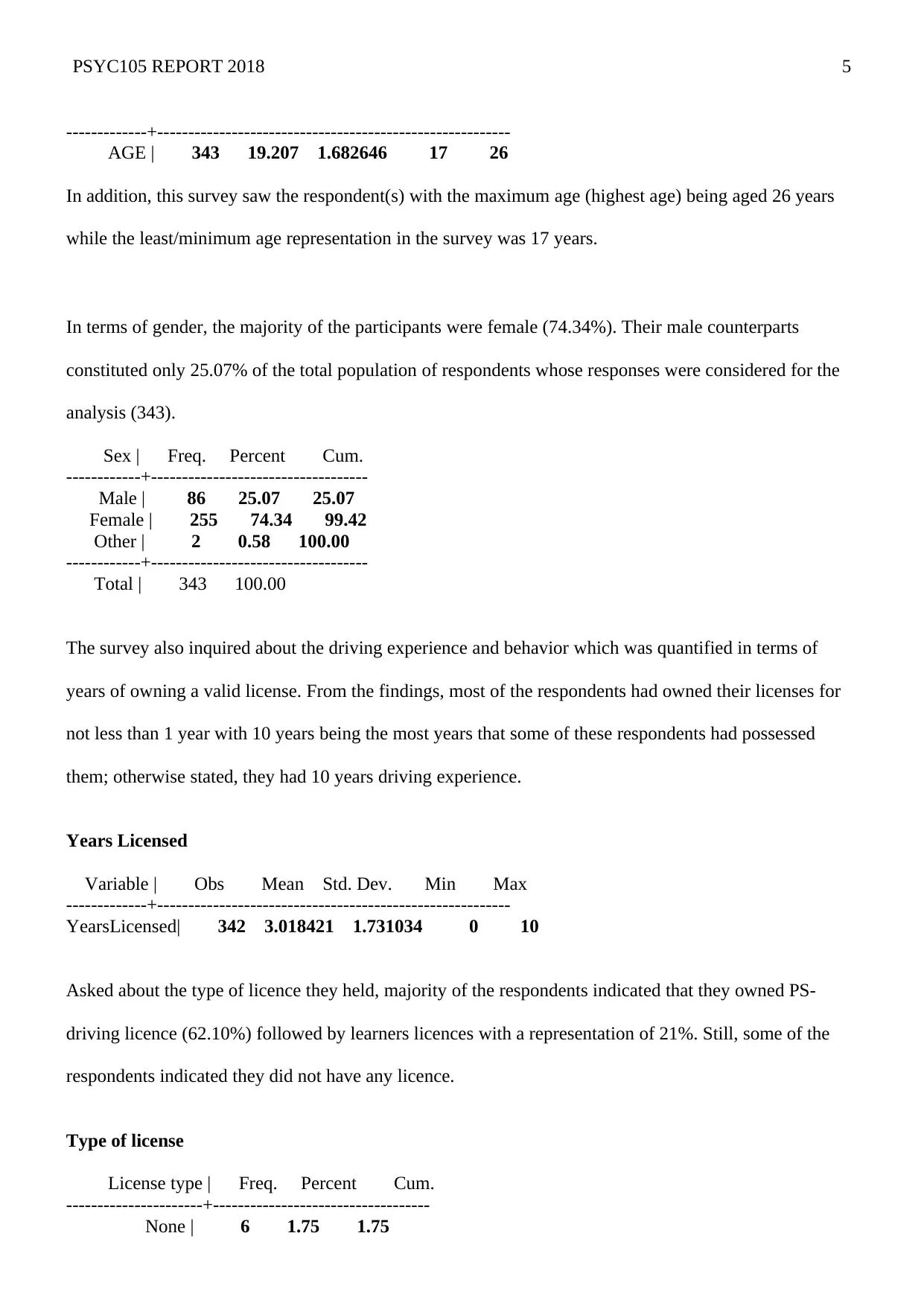
PSYC105 REPORT 2018 5
-------------+---------------------------------------------------------
AGE | 343 19.207 1.682646 17 26
In addition, this survey saw the respondent(s) with the maximum age (highest age) being aged 26 years
while the least/minimum age representation in the survey was 17 years.
In terms of gender, the majority of the participants were female (74.34%). Their male counterparts
constituted only 25.07% of the total population of respondents whose responses were considered for the
analysis (343).
Sex | Freq. Percent Cum.
------------+-----------------------------------
Male | 86 25.07 25.07
Female | 255 74.34 99.42
Other | 2 0.58 100.00
------------+-----------------------------------
Total | 343 100.00
The survey also inquired about the driving experience and behavior which was quantified in terms of
years of owning a valid license. From the findings, most of the respondents had owned their licenses for
not less than 1 year with 10 years being the most years that some of these respondents had possessed
them; otherwise stated, they had 10 years driving experience.
Years Licensed
Variable | Obs Mean Std. Dev. Min Max
-------------+---------------------------------------------------------
YearsLicensed| 342 3.018421 1.731034 0 10
Asked about the type of licence they held, majority of the respondents indicated that they owned PS-
driving licence (62.10%) followed by learners licences with a representation of 21%. Still, some of the
respondents indicated they did not have any licence.
Type of license
License type | Freq. Percent Cum.
----------------------+-----------------------------------
None | 6 1.75 1.75
-------------+---------------------------------------------------------
AGE | 343 19.207 1.682646 17 26
In addition, this survey saw the respondent(s) with the maximum age (highest age) being aged 26 years
while the least/minimum age representation in the survey was 17 years.
In terms of gender, the majority of the participants were female (74.34%). Their male counterparts
constituted only 25.07% of the total population of respondents whose responses were considered for the
analysis (343).
Sex | Freq. Percent Cum.
------------+-----------------------------------
Male | 86 25.07 25.07
Female | 255 74.34 99.42
Other | 2 0.58 100.00
------------+-----------------------------------
Total | 343 100.00
The survey also inquired about the driving experience and behavior which was quantified in terms of
years of owning a valid license. From the findings, most of the respondents had owned their licenses for
not less than 1 year with 10 years being the most years that some of these respondents had possessed
them; otherwise stated, they had 10 years driving experience.
Years Licensed
Variable | Obs Mean Std. Dev. Min Max
-------------+---------------------------------------------------------
YearsLicensed| 342 3.018421 1.731034 0 10
Asked about the type of licence they held, majority of the respondents indicated that they owned PS-
driving licence (62.10%) followed by learners licences with a representation of 21%. Still, some of the
respondents indicated they did not have any licence.
Type of license
License type | Freq. Percent Cum.
----------------------+-----------------------------------
None | 6 1.75 1.75

PSYC105 REPORT 2018 6
Learners | 74 21.57 23.32
Ps | 213 62.10 85.42
Full or heavy vehicle | 43 12.54 97.96
Motorcycle | 7 2.04 100.00
----------------------+-----------------------------------
Total | 343 100.00
About the use of mobile phone while driving question, the respondents responded as shown below.
Mobile phone use while driving
How often do YOU use your |
Phone while driving? | Freq. Percent Cum.
---------------------------+-----------------------------------
Three or more times a week | 47 13.70 13.70
Once or twice a week | 93 27.11 40.82
Once or twice a month | 35 10.20 51.02
Less than once a month | 61 17.78 68.80
Never | 107 31.20 100.00
---------------------------+-----------------------------------
Total | 343 100.00
From the recorded outcomes regarding this aspect of study, it is evident that they do not use their phones
while driving (31%). Still, a significant proportion of the respondents confessed to using their mobile
phones while driving once or twice a week (27%) with another group stating that they use mobile phone
while driving three or more times a week (13.70%).
The survey also wanted to assess the addiction level and thus tested the respondents about the use of
mobile phone in other places and not necessarily while only driving. Accordingly, most of the
respondents indicated they use their phones three or more times a week (56.56%) and others once or
twice a week (34.40%). These two groups formed more than 80% of the 343 respondents that participated
in this survey
Use of mobile phone in other places
How often do you think |
OTHERS use their phone? | Freq. Percent Cum.
---------------------------+-----------------------------------
Three or more times a week | 194 56.56 56.56
Once or twice a week | 118 34.40 90.96
Once or twice a month | 21 6.12 97.08
Less than once a month | 6 1.75 98.83
Never | 4 1.17 100.00
Learners | 74 21.57 23.32
Ps | 213 62.10 85.42
Full or heavy vehicle | 43 12.54 97.96
Motorcycle | 7 2.04 100.00
----------------------+-----------------------------------
Total | 343 100.00
About the use of mobile phone while driving question, the respondents responded as shown below.
Mobile phone use while driving
How often do YOU use your |
Phone while driving? | Freq. Percent Cum.
---------------------------+-----------------------------------
Three or more times a week | 47 13.70 13.70
Once or twice a week | 93 27.11 40.82
Once or twice a month | 35 10.20 51.02
Less than once a month | 61 17.78 68.80
Never | 107 31.20 100.00
---------------------------+-----------------------------------
Total | 343 100.00
From the recorded outcomes regarding this aspect of study, it is evident that they do not use their phones
while driving (31%). Still, a significant proportion of the respondents confessed to using their mobile
phones while driving once or twice a week (27%) with another group stating that they use mobile phone
while driving three or more times a week (13.70%).
The survey also wanted to assess the addiction level and thus tested the respondents about the use of
mobile phone in other places and not necessarily while only driving. Accordingly, most of the
respondents indicated they use their phones three or more times a week (56.56%) and others once or
twice a week (34.40%). These two groups formed more than 80% of the 343 respondents that participated
in this survey
Use of mobile phone in other places
How often do you think |
OTHERS use their phone? | Freq. Percent Cum.
---------------------------+-----------------------------------
Three or more times a week | 194 56.56 56.56
Once or twice a week | 118 34.40 90.96
Once or twice a month | 21 6.12 97.08
Less than once a month | 6 1.75 98.83
Never | 4 1.17 100.00
⊘ This is a preview!⊘
Do you want full access?
Subscribe today to unlock all pages.

Trusted by 1+ million students worldwide
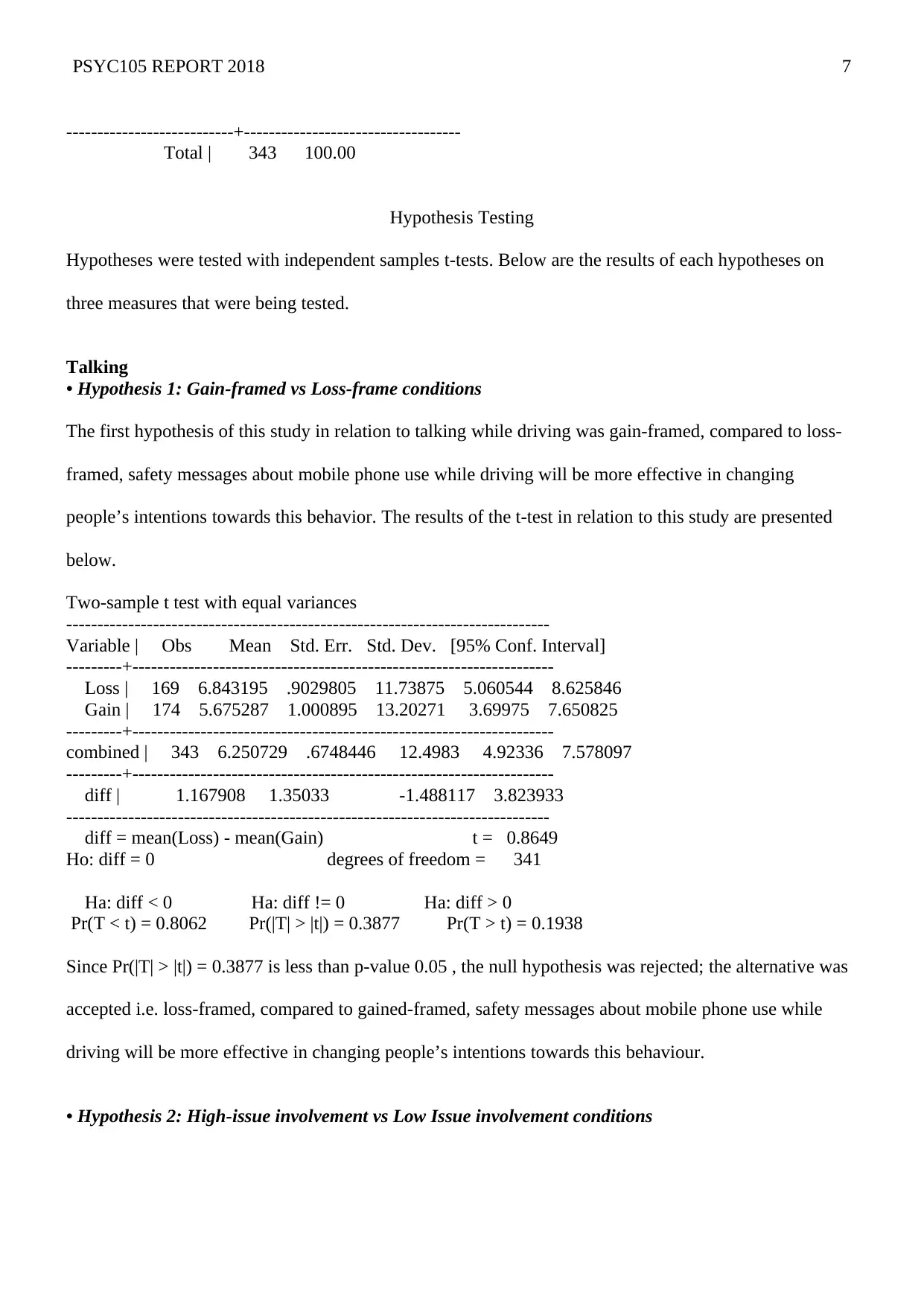
PSYC105 REPORT 2018 7
---------------------------+-----------------------------------
Total | 343 100.00
Hypothesis Testing
Hypotheses were tested with independent samples t-tests. Below are the results of each hypotheses on
three measures that were being tested.
Talking
• Hypothesis 1: Gain-framed vs Loss-frame conditions
The first hypothesis of this study in relation to talking while driving was gain-framed, compared to loss-
framed, safety messages about mobile phone use while driving will be more effective in changing
people’s intentions towards this behavior. The results of the t-test in relation to this study are presented
below.
Two-sample t test with equal variances
------------------------------------------------------------------------------
Variable | Obs Mean Std. Err. Std. Dev. [95% Conf. Interval]
---------+--------------------------------------------------------------------
Loss | 169 6.843195 .9029805 11.73875 5.060544 8.625846
Gain | 174 5.675287 1.000895 13.20271 3.69975 7.650825
---------+--------------------------------------------------------------------
combined | 343 6.250729 .6748446 12.4983 4.92336 7.578097
---------+--------------------------------------------------------------------
diff | 1.167908 1.35033 -1.488117 3.823933
------------------------------------------------------------------------------
diff = mean(Loss) - mean(Gain) t = 0.8649
Ho: diff = 0 degrees of freedom = 341
Ha: diff < 0 Ha: diff != 0 Ha: diff > 0
Pr(T < t) = 0.8062 Pr(|T| > |t|) = 0.3877 Pr(T > t) = 0.1938
Since Pr(|T| > |t|) = 0.3877 is less than p-value 0.05 , the null hypothesis was rejected; the alternative was
accepted i.e. loss-framed, compared to gained-framed, safety messages about mobile phone use while
driving will be more effective in changing people’s intentions towards this behaviour.
• Hypothesis 2: High-issue involvement vs Low Issue involvement conditions
---------------------------+-----------------------------------
Total | 343 100.00
Hypothesis Testing
Hypotheses were tested with independent samples t-tests. Below are the results of each hypotheses on
three measures that were being tested.
Talking
• Hypothesis 1: Gain-framed vs Loss-frame conditions
The first hypothesis of this study in relation to talking while driving was gain-framed, compared to loss-
framed, safety messages about mobile phone use while driving will be more effective in changing
people’s intentions towards this behavior. The results of the t-test in relation to this study are presented
below.
Two-sample t test with equal variances
------------------------------------------------------------------------------
Variable | Obs Mean Std. Err. Std. Dev. [95% Conf. Interval]
---------+--------------------------------------------------------------------
Loss | 169 6.843195 .9029805 11.73875 5.060544 8.625846
Gain | 174 5.675287 1.000895 13.20271 3.69975 7.650825
---------+--------------------------------------------------------------------
combined | 343 6.250729 .6748446 12.4983 4.92336 7.578097
---------+--------------------------------------------------------------------
diff | 1.167908 1.35033 -1.488117 3.823933
------------------------------------------------------------------------------
diff = mean(Loss) - mean(Gain) t = 0.8649
Ho: diff = 0 degrees of freedom = 341
Ha: diff < 0 Ha: diff != 0 Ha: diff > 0
Pr(T < t) = 0.8062 Pr(|T| > |t|) = 0.3877 Pr(T > t) = 0.1938
Since Pr(|T| > |t|) = 0.3877 is less than p-value 0.05 , the null hypothesis was rejected; the alternative was
accepted i.e. loss-framed, compared to gained-framed, safety messages about mobile phone use while
driving will be more effective in changing people’s intentions towards this behaviour.
• Hypothesis 2: High-issue involvement vs Low Issue involvement conditions
Paraphrase This Document
Need a fresh take? Get an instant paraphrase of this document with our AI Paraphraser
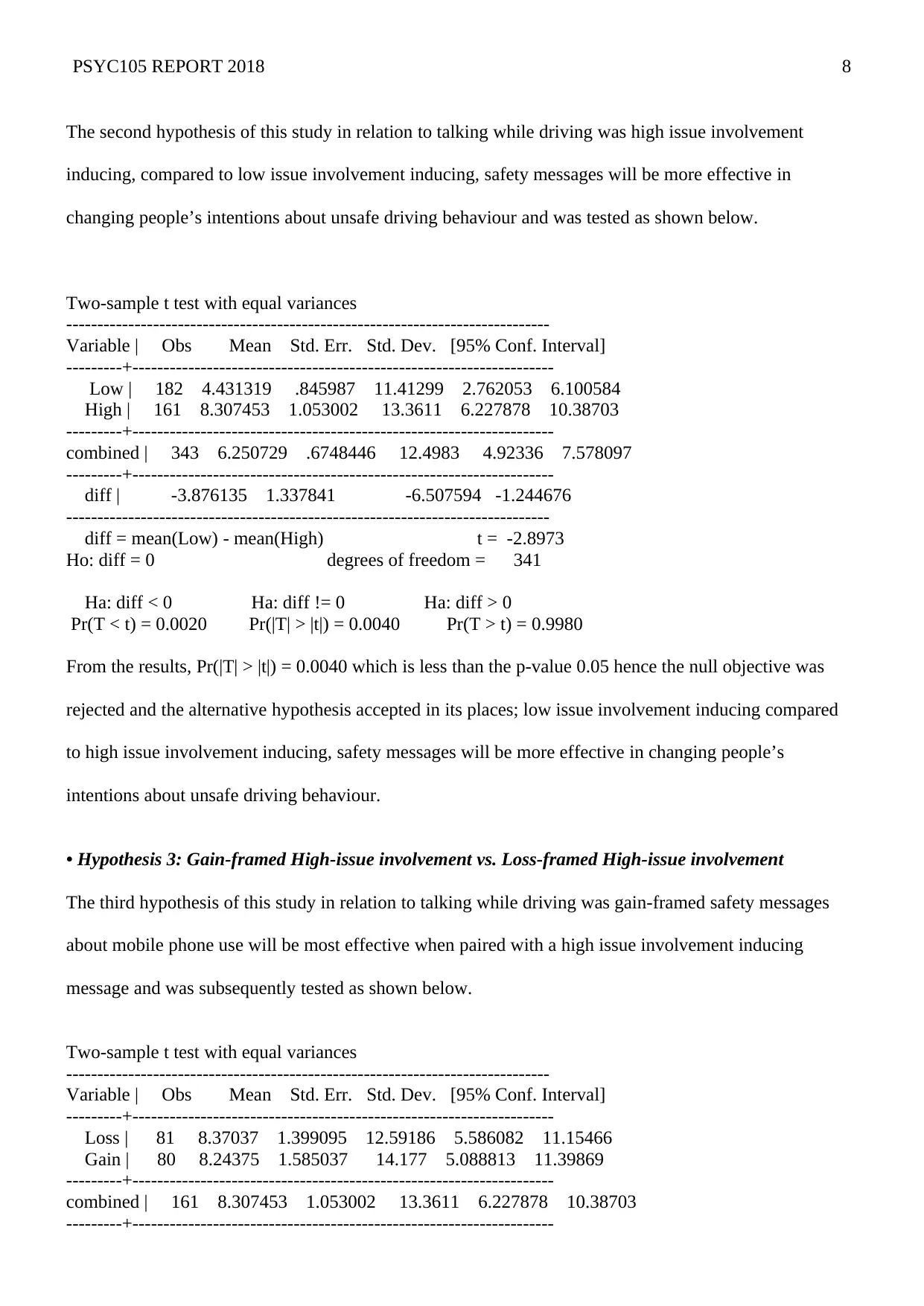
PSYC105 REPORT 2018 8
The second hypothesis of this study in relation to talking while driving was high issue involvement
inducing, compared to low issue involvement inducing, safety messages will be more effective in
changing people’s intentions about unsafe driving behaviour and was tested as shown below.
Two-sample t test with equal variances
------------------------------------------------------------------------------
Variable | Obs Mean Std. Err. Std. Dev. [95% Conf. Interval]
---------+--------------------------------------------------------------------
Low | 182 4.431319 .845987 11.41299 2.762053 6.100584
High | 161 8.307453 1.053002 13.3611 6.227878 10.38703
---------+--------------------------------------------------------------------
combined | 343 6.250729 .6748446 12.4983 4.92336 7.578097
---------+--------------------------------------------------------------------
diff | -3.876135 1.337841 -6.507594 -1.244676
------------------------------------------------------------------------------
diff = mean(Low) - mean(High) t = -2.8973
Ho: diff = 0 degrees of freedom = 341
Ha: diff < 0 Ha: diff != 0 Ha: diff > 0
Pr(T < t) = 0.0020 Pr(|T| > |t|) = 0.0040 Pr(T > t) = 0.9980
From the results, Pr(|T| > |t|) = 0.0040 which is less than the p-value 0.05 hence the null objective was
rejected and the alternative hypothesis accepted in its places; low issue involvement inducing compared
to high issue involvement inducing, safety messages will be more effective in changing people’s
intentions about unsafe driving behaviour.
• Hypothesis 3: Gain-framed High-issue involvement vs. Loss-framed High-issue involvement
The third hypothesis of this study in relation to talking while driving was gain-framed safety messages
about mobile phone use will be most effective when paired with a high issue involvement inducing
message and was subsequently tested as shown below.
Two-sample t test with equal variances
------------------------------------------------------------------------------
Variable | Obs Mean Std. Err. Std. Dev. [95% Conf. Interval]
---------+--------------------------------------------------------------------
Loss | 81 8.37037 1.399095 12.59186 5.586082 11.15466
Gain | 80 8.24375 1.585037 14.177 5.088813 11.39869
---------+--------------------------------------------------------------------
combined | 161 8.307453 1.053002 13.3611 6.227878 10.38703
---------+--------------------------------------------------------------------
The second hypothesis of this study in relation to talking while driving was high issue involvement
inducing, compared to low issue involvement inducing, safety messages will be more effective in
changing people’s intentions about unsafe driving behaviour and was tested as shown below.
Two-sample t test with equal variances
------------------------------------------------------------------------------
Variable | Obs Mean Std. Err. Std. Dev. [95% Conf. Interval]
---------+--------------------------------------------------------------------
Low | 182 4.431319 .845987 11.41299 2.762053 6.100584
High | 161 8.307453 1.053002 13.3611 6.227878 10.38703
---------+--------------------------------------------------------------------
combined | 343 6.250729 .6748446 12.4983 4.92336 7.578097
---------+--------------------------------------------------------------------
diff | -3.876135 1.337841 -6.507594 -1.244676
------------------------------------------------------------------------------
diff = mean(Low) - mean(High) t = -2.8973
Ho: diff = 0 degrees of freedom = 341
Ha: diff < 0 Ha: diff != 0 Ha: diff > 0
Pr(T < t) = 0.0020 Pr(|T| > |t|) = 0.0040 Pr(T > t) = 0.9980
From the results, Pr(|T| > |t|) = 0.0040 which is less than the p-value 0.05 hence the null objective was
rejected and the alternative hypothesis accepted in its places; low issue involvement inducing compared
to high issue involvement inducing, safety messages will be more effective in changing people’s
intentions about unsafe driving behaviour.
• Hypothesis 3: Gain-framed High-issue involvement vs. Loss-framed High-issue involvement
The third hypothesis of this study in relation to talking while driving was gain-framed safety messages
about mobile phone use will be most effective when paired with a high issue involvement inducing
message and was subsequently tested as shown below.
Two-sample t test with equal variances
------------------------------------------------------------------------------
Variable | Obs Mean Std. Err. Std. Dev. [95% Conf. Interval]
---------+--------------------------------------------------------------------
Loss | 81 8.37037 1.399095 12.59186 5.586082 11.15466
Gain | 80 8.24375 1.585037 14.177 5.088813 11.39869
---------+--------------------------------------------------------------------
combined | 161 8.307453 1.053002 13.3611 6.227878 10.38703
---------+--------------------------------------------------------------------
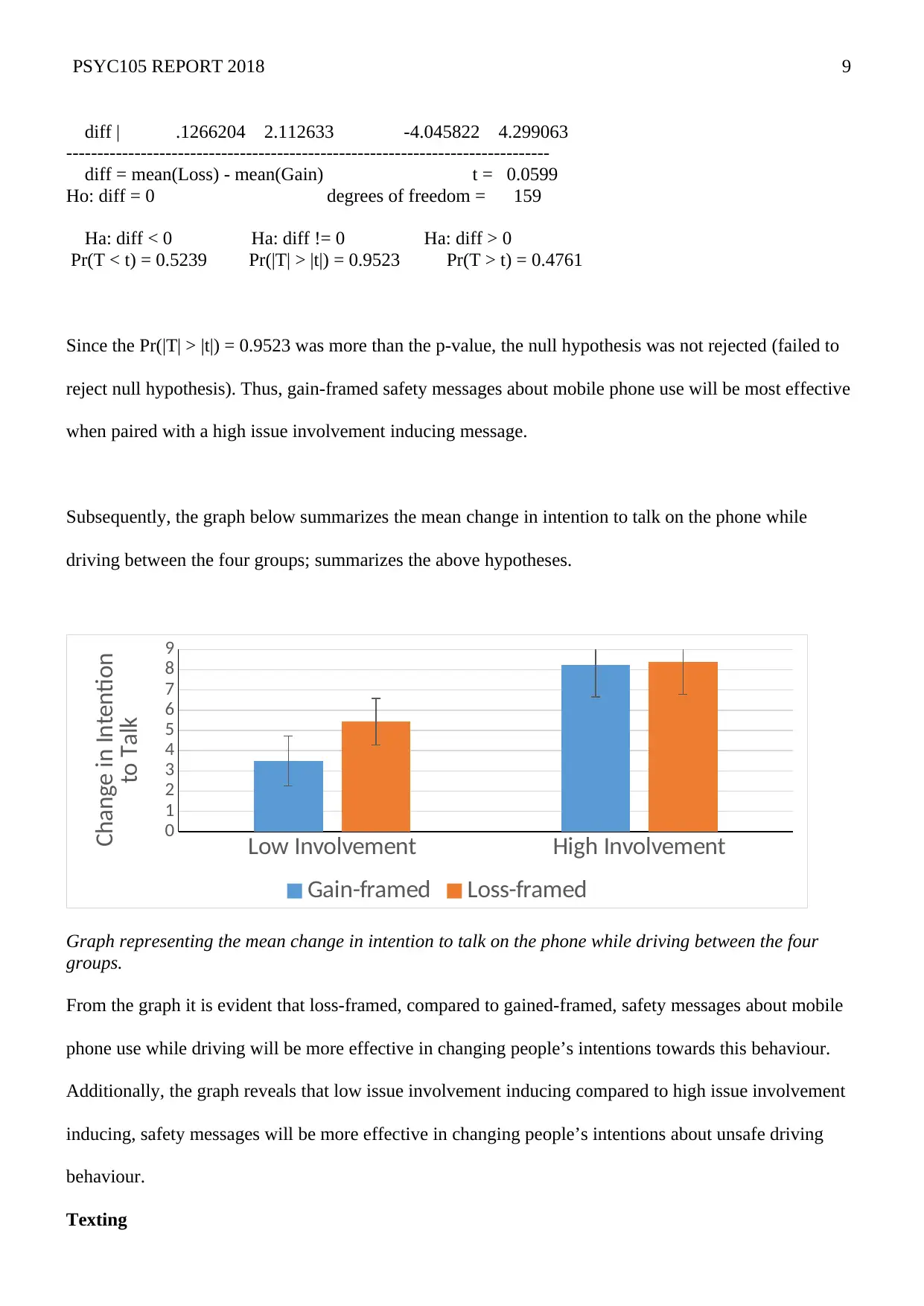
PSYC105 REPORT 2018 9
diff | .1266204 2.112633 -4.045822 4.299063
------------------------------------------------------------------------------
diff = mean(Loss) - mean(Gain) t = 0.0599
Ho: diff = 0 degrees of freedom = 159
Ha: diff < 0 Ha: diff != 0 Ha: diff > 0
Pr(T < t) = 0.5239 Pr(|T| > |t|) = 0.9523 Pr(T > t) = 0.4761
Since the Pr(|T| > |t|) = 0.9523 was more than the p-value, the null hypothesis was not rejected (failed to
reject null hypothesis). Thus, gain-framed safety messages about mobile phone use will be most effective
when paired with a high issue involvement inducing message.
Subsequently, the graph below summarizes the mean change in intention to talk on the phone while
driving between the four groups; summarizes the above hypotheses.
Low Involvement High Involvement
0
1
2
3
4
5
6
7
8
9
Gain-framed Loss-framed
Change in Intention
to Talk
Graph representing the mean change in intention to talk on the phone while driving between the four
groups.
From the graph it is evident that loss-framed, compared to gained-framed, safety messages about mobile
phone use while driving will be more effective in changing people’s intentions towards this behaviour.
Additionally, the graph reveals that low issue involvement inducing compared to high issue involvement
inducing, safety messages will be more effective in changing people’s intentions about unsafe driving
behaviour.
Texting
diff | .1266204 2.112633 -4.045822 4.299063
------------------------------------------------------------------------------
diff = mean(Loss) - mean(Gain) t = 0.0599
Ho: diff = 0 degrees of freedom = 159
Ha: diff < 0 Ha: diff != 0 Ha: diff > 0
Pr(T < t) = 0.5239 Pr(|T| > |t|) = 0.9523 Pr(T > t) = 0.4761
Since the Pr(|T| > |t|) = 0.9523 was more than the p-value, the null hypothesis was not rejected (failed to
reject null hypothesis). Thus, gain-framed safety messages about mobile phone use will be most effective
when paired with a high issue involvement inducing message.
Subsequently, the graph below summarizes the mean change in intention to talk on the phone while
driving between the four groups; summarizes the above hypotheses.
Low Involvement High Involvement
0
1
2
3
4
5
6
7
8
9
Gain-framed Loss-framed
Change in Intention
to Talk
Graph representing the mean change in intention to talk on the phone while driving between the four
groups.
From the graph it is evident that loss-framed, compared to gained-framed, safety messages about mobile
phone use while driving will be more effective in changing people’s intentions towards this behaviour.
Additionally, the graph reveals that low issue involvement inducing compared to high issue involvement
inducing, safety messages will be more effective in changing people’s intentions about unsafe driving
behaviour.
Texting
⊘ This is a preview!⊘
Do you want full access?
Subscribe today to unlock all pages.

Trusted by 1+ million students worldwide
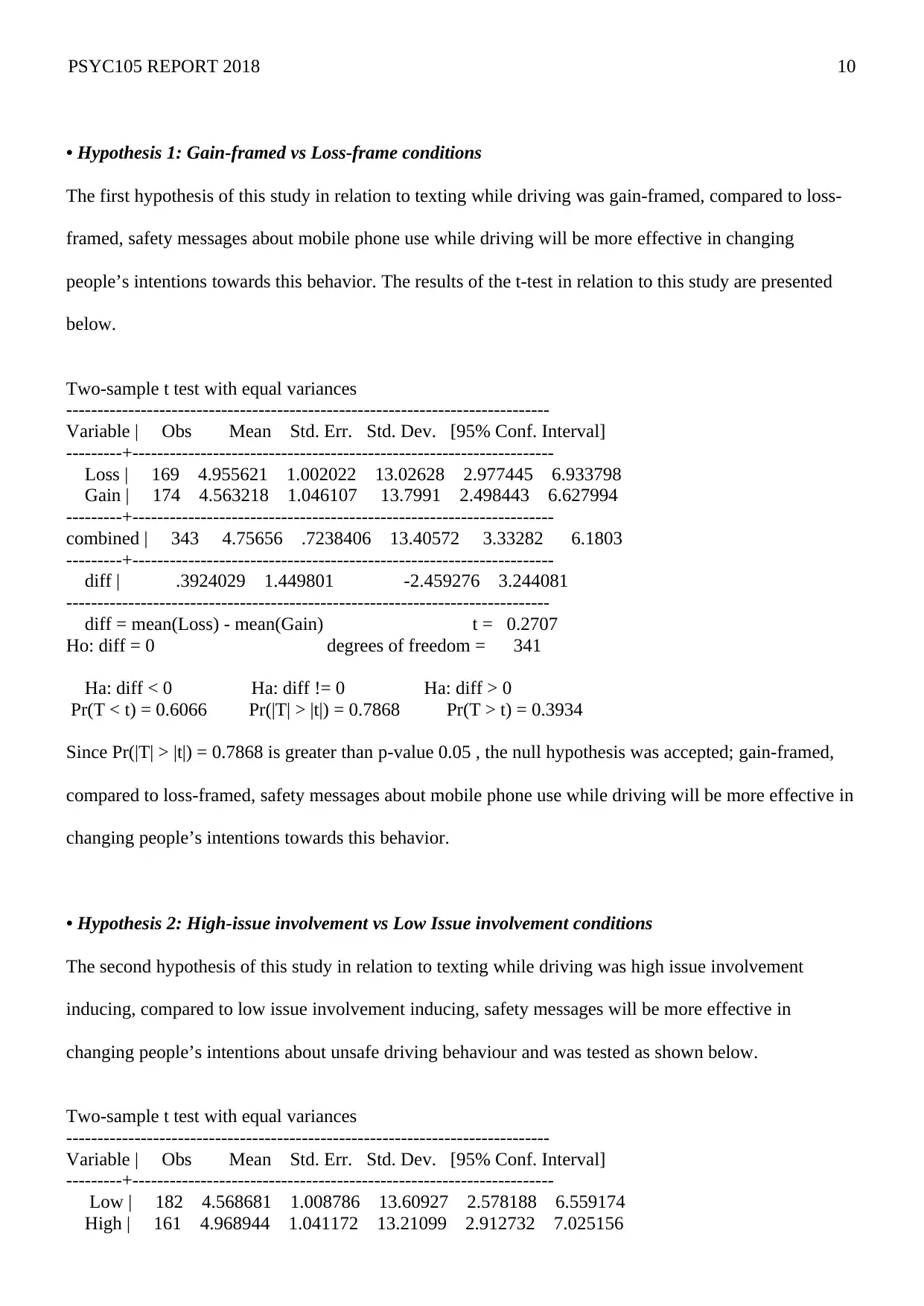
PSYC105 REPORT 2018 10
• Hypothesis 1: Gain-framed vs Loss-frame conditions
The first hypothesis of this study in relation to texting while driving was gain-framed, compared to loss-
framed, safety messages about mobile phone use while driving will be more effective in changing
people’s intentions towards this behavior. The results of the t-test in relation to this study are presented
below.
Two-sample t test with equal variances
------------------------------------------------------------------------------
Variable | Obs Mean Std. Err. Std. Dev. [95% Conf. Interval]
---------+--------------------------------------------------------------------
Loss | 169 4.955621 1.002022 13.02628 2.977445 6.933798
Gain | 174 4.563218 1.046107 13.7991 2.498443 6.627994
---------+--------------------------------------------------------------------
combined | 343 4.75656 .7238406 13.40572 3.33282 6.1803
---------+--------------------------------------------------------------------
diff | .3924029 1.449801 -2.459276 3.244081
------------------------------------------------------------------------------
diff = mean(Loss) - mean(Gain) t = 0.2707
Ho: diff = 0 degrees of freedom = 341
Ha: diff < 0 Ha: diff != 0 Ha: diff > 0
Pr(T < t) = 0.6066 Pr(|T| > |t|) = 0.7868 Pr(T > t) = 0.3934
Since Pr(|T| > |t|) = 0.7868 is greater than p-value 0.05 , the null hypothesis was accepted; gain-framed,
compared to loss-framed, safety messages about mobile phone use while driving will be more effective in
changing people’s intentions towards this behavior.
• Hypothesis 2: High-issue involvement vs Low Issue involvement conditions
The second hypothesis of this study in relation to texting while driving was high issue involvement
inducing, compared to low issue involvement inducing, safety messages will be more effective in
changing people’s intentions about unsafe driving behaviour and was tested as shown below.
Two-sample t test with equal variances
------------------------------------------------------------------------------
Variable | Obs Mean Std. Err. Std. Dev. [95% Conf. Interval]
---------+--------------------------------------------------------------------
Low | 182 4.568681 1.008786 13.60927 2.578188 6.559174
High | 161 4.968944 1.041172 13.21099 2.912732 7.025156
• Hypothesis 1: Gain-framed vs Loss-frame conditions
The first hypothesis of this study in relation to texting while driving was gain-framed, compared to loss-
framed, safety messages about mobile phone use while driving will be more effective in changing
people’s intentions towards this behavior. The results of the t-test in relation to this study are presented
below.
Two-sample t test with equal variances
------------------------------------------------------------------------------
Variable | Obs Mean Std. Err. Std. Dev. [95% Conf. Interval]
---------+--------------------------------------------------------------------
Loss | 169 4.955621 1.002022 13.02628 2.977445 6.933798
Gain | 174 4.563218 1.046107 13.7991 2.498443 6.627994
---------+--------------------------------------------------------------------
combined | 343 4.75656 .7238406 13.40572 3.33282 6.1803
---------+--------------------------------------------------------------------
diff | .3924029 1.449801 -2.459276 3.244081
------------------------------------------------------------------------------
diff = mean(Loss) - mean(Gain) t = 0.2707
Ho: diff = 0 degrees of freedom = 341
Ha: diff < 0 Ha: diff != 0 Ha: diff > 0
Pr(T < t) = 0.6066 Pr(|T| > |t|) = 0.7868 Pr(T > t) = 0.3934
Since Pr(|T| > |t|) = 0.7868 is greater than p-value 0.05 , the null hypothesis was accepted; gain-framed,
compared to loss-framed, safety messages about mobile phone use while driving will be more effective in
changing people’s intentions towards this behavior.
• Hypothesis 2: High-issue involvement vs Low Issue involvement conditions
The second hypothesis of this study in relation to texting while driving was high issue involvement
inducing, compared to low issue involvement inducing, safety messages will be more effective in
changing people’s intentions about unsafe driving behaviour and was tested as shown below.
Two-sample t test with equal variances
------------------------------------------------------------------------------
Variable | Obs Mean Std. Err. Std. Dev. [95% Conf. Interval]
---------+--------------------------------------------------------------------
Low | 182 4.568681 1.008786 13.60927 2.578188 6.559174
High | 161 4.968944 1.041172 13.21099 2.912732 7.025156
Paraphrase This Document
Need a fresh take? Get an instant paraphrase of this document with our AI Paraphraser
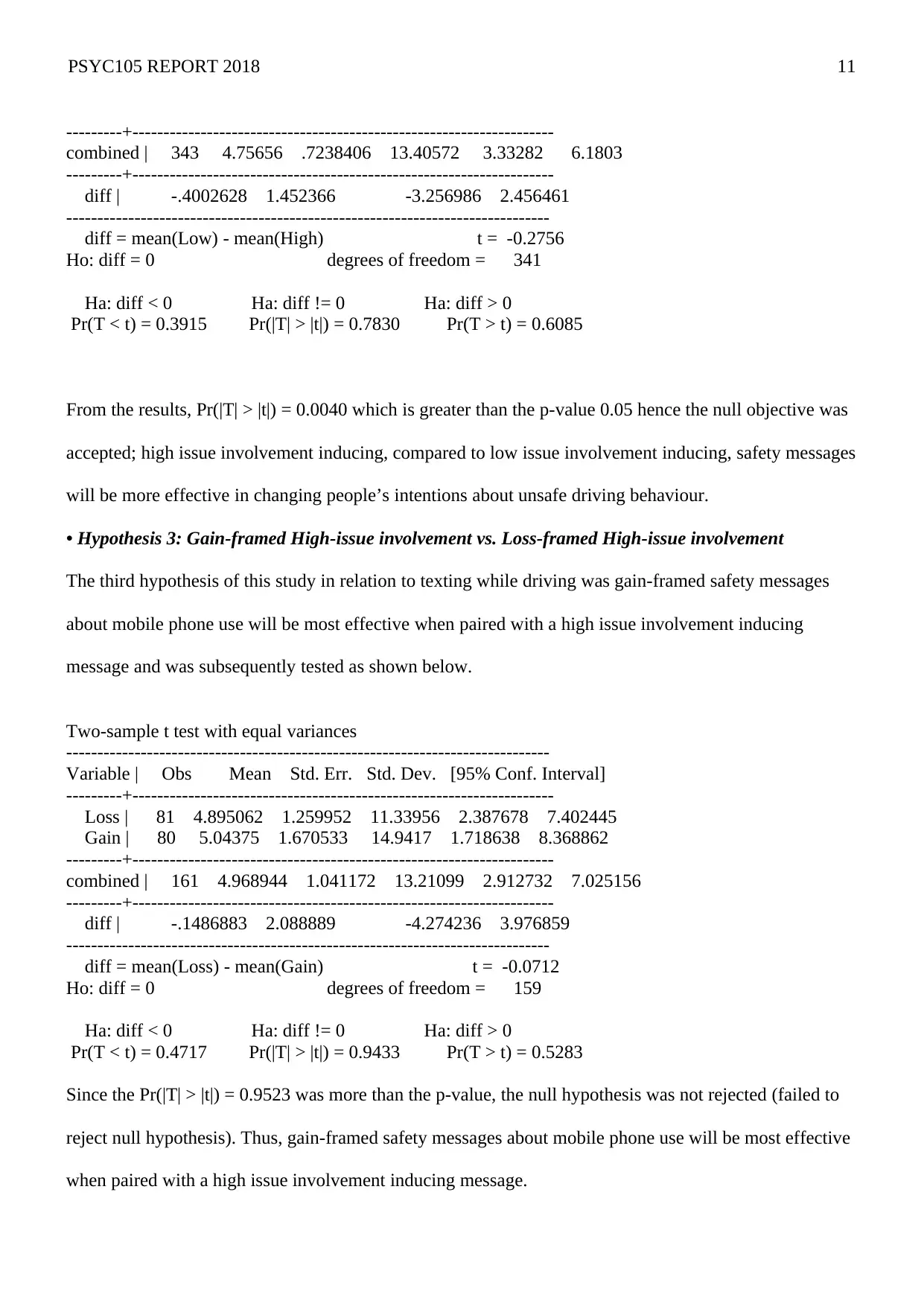
PSYC105 REPORT 2018 11
---------+--------------------------------------------------------------------
combined | 343 4.75656 .7238406 13.40572 3.33282 6.1803
---------+--------------------------------------------------------------------
diff | -.4002628 1.452366 -3.256986 2.456461
------------------------------------------------------------------------------
diff = mean(Low) - mean(High) t = -0.2756
Ho: diff = 0 degrees of freedom = 341
Ha: diff < 0 Ha: diff != 0 Ha: diff > 0
Pr(T < t) = 0.3915 Pr(|T| > |t|) = 0.7830 Pr(T > t) = 0.6085
From the results, Pr(|T| > |t|) = 0.0040 which is greater than the p-value 0.05 hence the null objective was
accepted; high issue involvement inducing, compared to low issue involvement inducing, safety messages
will be more effective in changing people’s intentions about unsafe driving behaviour.
• Hypothesis 3: Gain-framed High-issue involvement vs. Loss-framed High-issue involvement
The third hypothesis of this study in relation to texting while driving was gain-framed safety messages
about mobile phone use will be most effective when paired with a high issue involvement inducing
message and was subsequently tested as shown below.
Two-sample t test with equal variances
------------------------------------------------------------------------------
Variable | Obs Mean Std. Err. Std. Dev. [95% Conf. Interval]
---------+--------------------------------------------------------------------
Loss | 81 4.895062 1.259952 11.33956 2.387678 7.402445
Gain | 80 5.04375 1.670533 14.9417 1.718638 8.368862
---------+--------------------------------------------------------------------
combined | 161 4.968944 1.041172 13.21099 2.912732 7.025156
---------+--------------------------------------------------------------------
diff | -.1486883 2.088889 -4.274236 3.976859
------------------------------------------------------------------------------
diff = mean(Loss) - mean(Gain) t = -0.0712
Ho: diff = 0 degrees of freedom = 159
Ha: diff < 0 Ha: diff != 0 Ha: diff > 0
Pr(T < t) = 0.4717 Pr(|T| > |t|) = 0.9433 Pr(T > t) = 0.5283
Since the Pr(|T| > |t|) = 0.9523 was more than the p-value, the null hypothesis was not rejected (failed to
reject null hypothesis). Thus, gain-framed safety messages about mobile phone use will be most effective
when paired with a high issue involvement inducing message.
---------+--------------------------------------------------------------------
combined | 343 4.75656 .7238406 13.40572 3.33282 6.1803
---------+--------------------------------------------------------------------
diff | -.4002628 1.452366 -3.256986 2.456461
------------------------------------------------------------------------------
diff = mean(Low) - mean(High) t = -0.2756
Ho: diff = 0 degrees of freedom = 341
Ha: diff < 0 Ha: diff != 0 Ha: diff > 0
Pr(T < t) = 0.3915 Pr(|T| > |t|) = 0.7830 Pr(T > t) = 0.6085
From the results, Pr(|T| > |t|) = 0.0040 which is greater than the p-value 0.05 hence the null objective was
accepted; high issue involvement inducing, compared to low issue involvement inducing, safety messages
will be more effective in changing people’s intentions about unsafe driving behaviour.
• Hypothesis 3: Gain-framed High-issue involvement vs. Loss-framed High-issue involvement
The third hypothesis of this study in relation to texting while driving was gain-framed safety messages
about mobile phone use will be most effective when paired with a high issue involvement inducing
message and was subsequently tested as shown below.
Two-sample t test with equal variances
------------------------------------------------------------------------------
Variable | Obs Mean Std. Err. Std. Dev. [95% Conf. Interval]
---------+--------------------------------------------------------------------
Loss | 81 4.895062 1.259952 11.33956 2.387678 7.402445
Gain | 80 5.04375 1.670533 14.9417 1.718638 8.368862
---------+--------------------------------------------------------------------
combined | 161 4.968944 1.041172 13.21099 2.912732 7.025156
---------+--------------------------------------------------------------------
diff | -.1486883 2.088889 -4.274236 3.976859
------------------------------------------------------------------------------
diff = mean(Loss) - mean(Gain) t = -0.0712
Ho: diff = 0 degrees of freedom = 159
Ha: diff < 0 Ha: diff != 0 Ha: diff > 0
Pr(T < t) = 0.4717 Pr(|T| > |t|) = 0.9433 Pr(T > t) = 0.5283
Since the Pr(|T| > |t|) = 0.9523 was more than the p-value, the null hypothesis was not rejected (failed to
reject null hypothesis). Thus, gain-framed safety messages about mobile phone use will be most effective
when paired with a high issue involvement inducing message.

PSYC105 REPORT 2018 12
The above findings about the three hypotheses were summarized in form of a box plot shown below.
Low Involvement High Involvement
0
2
4
6
8
10
12
Gain-framed Loss-framed
Change in Intention to Text
Graph representing the mean change in intention to text while driving between the four groups.
From the graph it is evident that gain-framed, compared to loss-framed, safety messages about mobile
phone use while driving will be more effective in changing people’s intentions towards this behavior. In
addition, high issue involvement inducing, compared to low issue involvement inducing, safety messages
will be more effective in changing people’s intentions about unsafe driving behaviour.
Discussion
The findings of the data analysis reveals that there is sufficient evidence to back the premise that some
individual variances make some teenagers and young adult drivers more prone to calling/texting while
driving than others. For example, those teenagers and young adult drivers who are certain that they are
able to drive safely while calling or texting and those who have a sensation that their dear ones do not
have an issue with them texting/calling while driving are more expected to do so (Nathanail & Adamos,
2013). Contrariwise, those teens and young adult drivers who perceive hidden texting and driving
negatively, were less expected to engage in the behaviour (Chaurand, Bossart, & Delhomme, 2015).
Based on these results, some submissions can be made concerning training targeting teens and young
adult drivers. First, to help these group of people understand the real perils related with texting/calling
The above findings about the three hypotheses were summarized in form of a box plot shown below.
Low Involvement High Involvement
0
2
4
6
8
10
12
Gain-framed Loss-framed
Change in Intention to Text
Graph representing the mean change in intention to text while driving between the four groups.
From the graph it is evident that gain-framed, compared to loss-framed, safety messages about mobile
phone use while driving will be more effective in changing people’s intentions towards this behavior. In
addition, high issue involvement inducing, compared to low issue involvement inducing, safety messages
will be more effective in changing people’s intentions about unsafe driving behaviour.
Discussion
The findings of the data analysis reveals that there is sufficient evidence to back the premise that some
individual variances make some teenagers and young adult drivers more prone to calling/texting while
driving than others. For example, those teenagers and young adult drivers who are certain that they are
able to drive safely while calling or texting and those who have a sensation that their dear ones do not
have an issue with them texting/calling while driving are more expected to do so (Nathanail & Adamos,
2013). Contrariwise, those teens and young adult drivers who perceive hidden texting and driving
negatively, were less expected to engage in the behaviour (Chaurand, Bossart, & Delhomme, 2015).
Based on these results, some submissions can be made concerning training targeting teens and young
adult drivers. First, to help these group of people understand the real perils related with texting/calling
⊘ This is a preview!⊘
Do you want full access?
Subscribe today to unlock all pages.

Trusted by 1+ million students worldwide
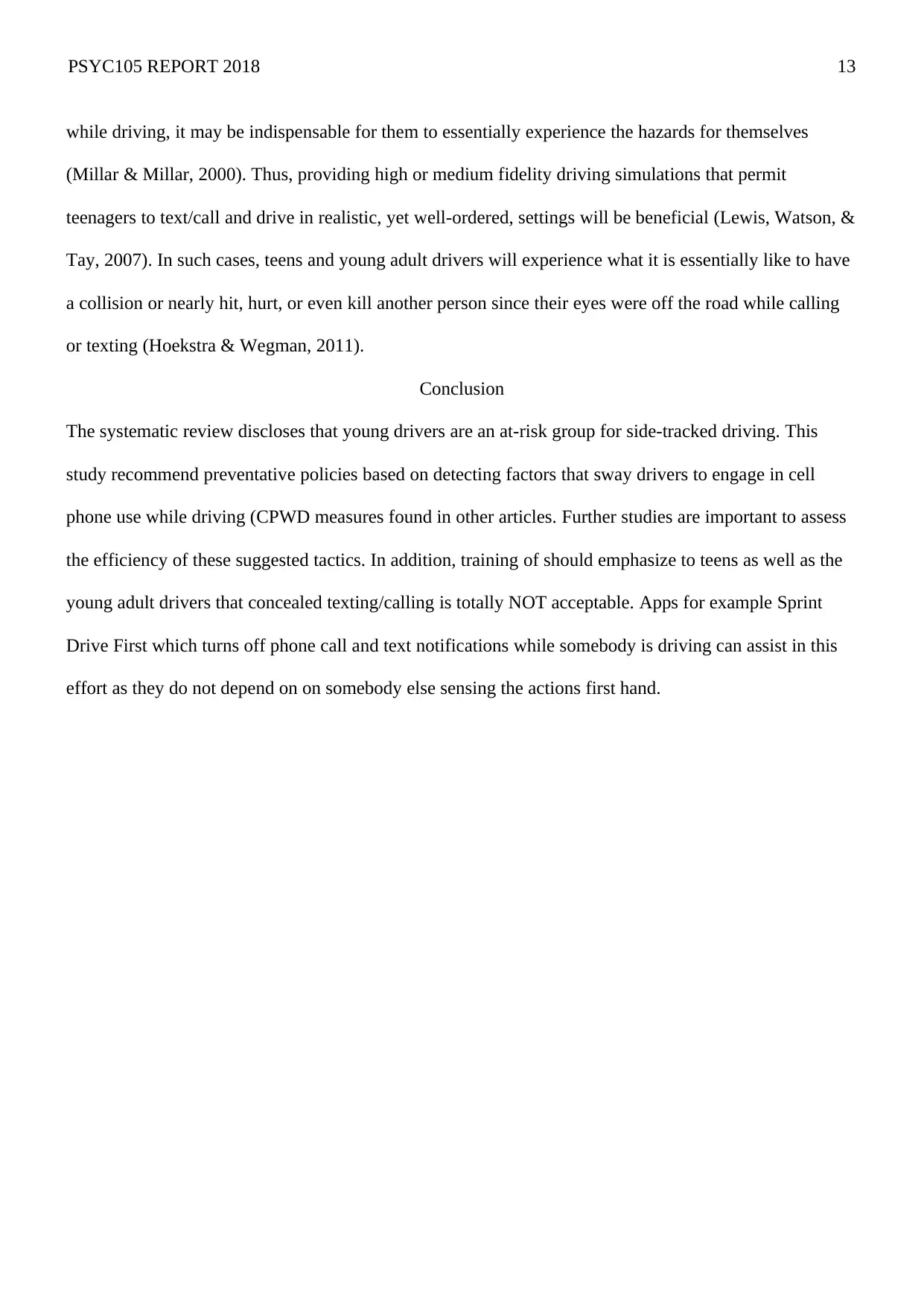
PSYC105 REPORT 2018 13
while driving, it may be indispensable for them to essentially experience the hazards for themselves
(Millar & Millar, 2000). Thus, providing high or medium fidelity driving simulations that permit
teenagers to text/call and drive in realistic, yet well-ordered, settings will be beneficial (Lewis, Watson, &
Tay, 2007). In such cases, teens and young adult drivers will experience what it is essentially like to have
a collision or nearly hit, hurt, or even kill another person since their eyes were off the road while calling
or texting (Hoekstra & Wegman, 2011).
Conclusion
The systematic review discloses that young drivers are an at-risk group for side-tracked driving. This
study recommend preventative policies based on detecting factors that sway drivers to engage in cell
phone use while driving (CPWD measures found in other articles. Further studies are important to assess
the efficiency of these suggested tactics. In addition, training of should emphasize to teens as well as the
young adult drivers that concealed texting/calling is totally NOT acceptable. Apps for example Sprint
Drive First which turns off phone call and text notifications while somebody is driving can assist in this
effort as they do not depend on on somebody else sensing the actions first hand.
while driving, it may be indispensable for them to essentially experience the hazards for themselves
(Millar & Millar, 2000). Thus, providing high or medium fidelity driving simulations that permit
teenagers to text/call and drive in realistic, yet well-ordered, settings will be beneficial (Lewis, Watson, &
Tay, 2007). In such cases, teens and young adult drivers will experience what it is essentially like to have
a collision or nearly hit, hurt, or even kill another person since their eyes were off the road while calling
or texting (Hoekstra & Wegman, 2011).
Conclusion
The systematic review discloses that young drivers are an at-risk group for side-tracked driving. This
study recommend preventative policies based on detecting factors that sway drivers to engage in cell
phone use while driving (CPWD measures found in other articles. Further studies are important to assess
the efficiency of these suggested tactics. In addition, training of should emphasize to teens as well as the
young adult drivers that concealed texting/calling is totally NOT acceptable. Apps for example Sprint
Drive First which turns off phone call and text notifications while somebody is driving can assist in this
effort as they do not depend on on somebody else sensing the actions first hand.
Paraphrase This Document
Need a fresh take? Get an instant paraphrase of this document with our AI Paraphraser

PSYC105 REPORT 2018 14
References
Cazzulino, F., Burke, R. V., Muller, V., Arbogast. H. & Upperman, J. S. (2014). Cell Phones and Young
Drivers: A systematic review regarding the association between psychological factors and
prevention. Traffic Injury Prevention, 15, 234-242.
Chaurand, N., Bossart, F. & Delhomme, P. (2015). A naturalistic study of the impact of message framing
on highway speeding. Transport Research Part F, 35, 37-44.
Darçın, M., & Alkan, M. (2015). Safety Risk of Mobile Phone Use While Driving In Sample of Taxi
Drivers. Promet - Traffic& Transportation, 27(4), 21-49. doi:10.7307/ptt.v27i4.1597
Hallett, C., Lambert, A., & Regan, M. A. (2012). Text messaging amongst New Zealand drivers:
Prevalence and risk perception. Transportation Research Part F: Traffic Psychology and
Behaviour, 15(3), 261-271. doi:10.1016/j.trf.2011.12.002
Hoekstra, T. & Wegman, F. (2011). Improving the effectiveness of road safety campaigns: Current and
new practices. IATSS Research, 34, 80-86.
Miller, M. G. & Miller. K. U. (2000). Promoting Safe Driving Behaviours: The influence of message
framing and issue involvement. Journal of Applied Social Psychology, 30 (4), 853-866.
Waddell, L. P., & Wiener, K. K. (2014). What’s driving illegal mobile phone use? Psychosocial
influences on drivers’ intentions to use hand-held mobile phones. Transportation Research Part F:
Traffic Psychology and Behaviour, 22, 1-11. doi:10.1016/j.trf.2013.10.008
White, K. M., Hyde, M. K., Walsh, S. P., & Watson, B. (2010). Mobile phone use while driving: An
investigation of the beliefs influencing drivers’ hands-free and hand-held mobile phone use.
Transportation Research Part F: Traffic Psychology and Behaviour, 13(1), 9-20.
doi:10.1016/j.trf.2009.09.004
References
Cazzulino, F., Burke, R. V., Muller, V., Arbogast. H. & Upperman, J. S. (2014). Cell Phones and Young
Drivers: A systematic review regarding the association between psychological factors and
prevention. Traffic Injury Prevention, 15, 234-242.
Chaurand, N., Bossart, F. & Delhomme, P. (2015). A naturalistic study of the impact of message framing
on highway speeding. Transport Research Part F, 35, 37-44.
Darçın, M., & Alkan, M. (2015). Safety Risk of Mobile Phone Use While Driving In Sample of Taxi
Drivers. Promet - Traffic& Transportation, 27(4), 21-49. doi:10.7307/ptt.v27i4.1597
Hallett, C., Lambert, A., & Regan, M. A. (2012). Text messaging amongst New Zealand drivers:
Prevalence and risk perception. Transportation Research Part F: Traffic Psychology and
Behaviour, 15(3), 261-271. doi:10.1016/j.trf.2011.12.002
Hoekstra, T. & Wegman, F. (2011). Improving the effectiveness of road safety campaigns: Current and
new practices. IATSS Research, 34, 80-86.
Miller, M. G. & Miller. K. U. (2000). Promoting Safe Driving Behaviours: The influence of message
framing and issue involvement. Journal of Applied Social Psychology, 30 (4), 853-866.
Waddell, L. P., & Wiener, K. K. (2014). What’s driving illegal mobile phone use? Psychosocial
influences on drivers’ intentions to use hand-held mobile phones. Transportation Research Part F:
Traffic Psychology and Behaviour, 22, 1-11. doi:10.1016/j.trf.2013.10.008
White, K. M., Hyde, M. K., Walsh, S. P., & Watson, B. (2010). Mobile phone use while driving: An
investigation of the beliefs influencing drivers’ hands-free and hand-held mobile phone use.
Transportation Research Part F: Traffic Psychology and Behaviour, 13(1), 9-20.
doi:10.1016/j.trf.2009.09.004
1 out of 14
Related Documents
Your All-in-One AI-Powered Toolkit for Academic Success.
+13062052269
info@desklib.com
Available 24*7 on WhatsApp / Email
![[object Object]](/_next/static/media/star-bottom.7253800d.svg)
Unlock your academic potential
© 2024 | Zucol Services PVT LTD | All rights reserved.



